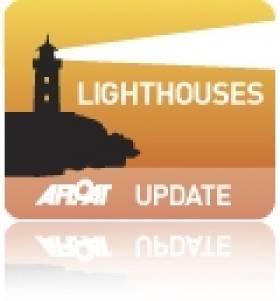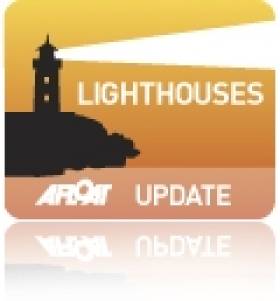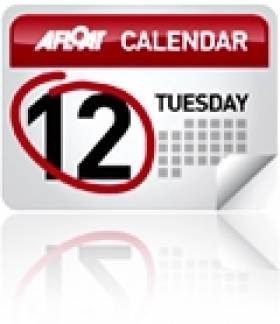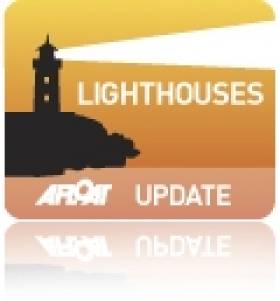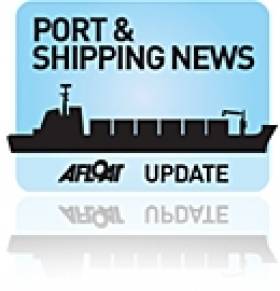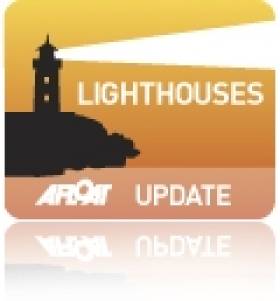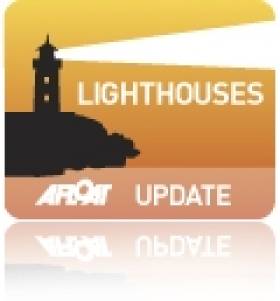Displaying items by tag: lighthouses
On Sunday the 2nd of June the Valentia Island Lighthouse will be officially open to the public for the first time. The project will put this heritage site in the hands of the community with a long term lease to manage the project as a tourist attraction. Initially the public will be offered guided tours into the lighthouse tower and balcony.
A marketing and fundraising plan is being put in place to develop the site over the next couple of years to make this a high quality tourist attraction and it is expected that this will attract 40-50,000 visitors a year to Valentia. Future plans include the conversion of the Lighthouse Keeper's house as a visitor centre and the development of the archaeological potential at Cromwell Fort.
Brian Morgan from the Valentia Island Development Committee said "The site on Valentia has huge tourism potential and will provide a much needed boost to the local economy".
"As well as local land owners the Kerry County Council has provided terrific help from the beginning and are strongly supporting this project as a key tourism project for the county" he added.
Cromwell Point Lighthouse is maintained by the Commissioners of Irish Lights and is a harbour light to guide vessels from the sea and lead them through the northern entrance of Valentia Harbour past Harbour Rock.
The site of the Cromwell Point Lighthouse was originally home to a Cromwell Feetwood Fort believed to have been built in the 16th century which was one of two built on Valentia Island around this time. The outline of the Cromwell Point fort with its bastions and barrack inside its wall can still be easily traced from the air, lying just inside the lighthouse enclosure wall. The fort was maintained after the Restoration and there are various State Paper entries about its repair over the period 1663-1665. It was disestablished in 1669. The first light for Cromwell Point was originally applied for on 30 March 1828 by the Right Honorary Maurice Fitzgerald, Knight of Kerry. Work commenced on the lighthouse ten years later in 1838, the light was first exhibited on 1 February 1841. Since November 1947 the light has been automated.
An official opening of the lighthouse will take place during the June weekend to coincide with the Transatlantic Communications and Light Gathering. One of the other highlights of the weekend will be the attendance of Professor Alexander Gillespie who will discuss the importance of Valentia's link to the Transatlantic Cable and the opportunity to explore the International heritage significance of the Cable Station. Professor Gillespie is the first New Zealander to be named Rapporteur for the World Heritage Convention. This is an event that will celebrate the island's rich heritage with the Transatlantic Cable and communications will be a major theme over the weekend. All three communications elements on the Island; the cable station, the radio station, and the lighthouse will be explored through a series of insightful and interesting lectures. There will also be the opportunity to take various tours of these significant sites. As well as soaking up the traditional island welcome and some great live music this weekend will afford you the opportunity to mingle in the company of friends old and new. 'We aim to celebrate with the wider community, to reunite the family descendants' who were part of that glorious age, and also tell the world that Valentia is ready to once again take its rightful place as a centre for heritage preservation and communications innovation' said Anthony O'Connell Chairman of the Valentia Island Development Committee.
For more information on this exciting event visit www.valentiawelcomestheworld.com or call Valentia Island Tourist Office on +353 (66) 9476985 or email [email protected]
German Media Treated To Loop Head Lighthouse Tour
#Lighthouse - German journalists were recently taken on a tour of Loop Head Lighthouse to give our European neighbours a taste of Ireland's maritime heritage.
The group - including writers from the likes of respected news magazine Der Spiegel - visited the 19th-century landmark in Co Clare which opened to visitors at weekends earlier this month, and will be open seven days a week from the June Bank Holiday over the summer season for the third year running.
Before then, it will welcome visitors during the National Famine Commemoration programme from 3-12 May.
As previously reported on Afloat.ie, the lighthouse at the mouth of the Shannon Estuary has proven a major tourism draw, with its 11-week trial opening in 2011 estimated to be worth €400,000 to the local economy.
Lighthouse Tender Carries Out Trial Runs Since Modifications
#LighthouseTender- ILV Granuaile the aids to navigation tender is carrying out another trial run of systems at sea today in Dublin Bay and off Greystones, writes Jehan Ashmore.
As previously reported on Afloat.ie, the Commissioners of Irish Lights 79m tender had undergone work that has involved the installation of a new radar mast, calorifier units and modifications to the bridge.
Arklow Marine Services carried out the work while the vessel was berthed in the port along Sir John Rogersons Quay.
The 2,625 tonnes buoy-handling vessel is expected to return to her homeport of Dun Laoghaire Harbour tonight.
Lecture: The Lighthouses of the South West Coast
#Lecture – The next Howth Peninsula Heritage Society lecture will be about 'The Lighthouses of the South West Coast.
The lecture to be presented by Gerry Butler is to takes place in the Howth Angling Centre along the West Pier, on Tuesday 26 March starting at 8 pm.
Those arriving by train only have a short stroll to the venue from Howth DART station.
All are welcome to the lecture which is admission free to members and to non-members €4 payable at the door.
Loop Head Lighthouse Opens for 2013 Tourist Season
#loophead – The 2013 tourist season at Loop Head Lighthouse in County Clare commences this weekend as the West Clare landmark opens to the public for the first time this year.
The 19th century lighthouse will be opened for its third successive season on Saturday and will remain open each weekend, including Easter Weekend and Bank Holidays, up to and including September. Clare County Council says 12 full-time and part-time jobs will be created when the Lighthouse reopens.
Loop Head Lighthouse, located at the mouth of the Shannon Estuary, is steeped in history and rich in maritime heritage with its origins dating back to the 1670s. The existing tower style lighthouse was constructed in 1854 and was operated and maintained by a keeper who lived within the lighthouse compound. In January 1991, the lighthouse was converted to automatic operation, and today is in the care of an attendant and is also monitored by the CIL. In July 2011, Clare County Council, with the support and cooperation of CIL, Shannon Development and Loop Head Tourism, opened the Lighthouse as a visitor attraction on a trial basis.
The Lighthouse made national headlines last year when Taoiseach Enda Kenny, whose own grandfather was a Lightkeeper at Loop Head during the 1930s, and his family visited the historic maritime building. Dr. Aleida Guevara March, the eldest daughter of revolutionary figure Ernesto "Che" Guevara, also visited in late September, while the Lighthouse was one of 400 lighthouses and lightships in 50 countries to participate in the 15th International Lighthouse Lightship Weekend.
17,423 people (13,441 adults, 3,982 children) visited the lighthouse during the May to September opening period in 2012. 71% of the total visitor figure was represented by domestic visitors, of which approximately 50% were holidaymakers and 35% were day-trippers, with local visitors accounting for the remainder. Overseas visitors accounted for 29% of the total figure. It is estimated that the 18-week opening period was worth approximately €650,000 to the local economy.
Speaking ahead of the weekend opening, Gerard Dollard, Director of Services with Clare County Council said: "Clare tourism, particularly the sector in the Loop Head Peninsula, has benefited greatly from this visitor project and we look forward to welcoming thousands of people to the Lighthouse again this year. This is a very special year being the year of the Gathering and also the year in which Kilrush will host a 10 day programme for the National Famine Commemoration in May. The opening of the lighthouse complements the existing, quality tourism product on offer in the Loop Head Peninsula and wider West Clare area."
Modification Work for Irish Lights Aids to Navigation Vessel
#LighthouseTender – The Commissioners of Irish Lights ILV Granuaile (2000/2,625grt) an aids to navigation tender vessel, is undergoing steel modification works while berthed in Dublin Port, writes Jehan Ashmore.
Work on the 79m long tender which is moored at Sir John Rogersons' Quay close to the East-Link Bridge, is been carried out by Arklow Marine Services.
The work involves fabricating of a new radar mast, installation of calorifier units and modifications to the bridge.
Steel work modifications entail fitting under deck strengthening in way of ROV pads which are to be in accordance and to the approval of Lloyds.
Killybeg based Barry Electronics are supplying and fitting a new radar which requires a new mast with existing steelwork and platform being removed.
The new calorifier unit which is to replace existing plant will be piped in using 316 stainless steel pipe materials. It is expected the quayside work be completed by the middle of this month.
ILV Granuaile is the third tender to carry the name of the famous Mayo pirate Queen.
She was built by the Damen Shipyards Group, where the hull and superstructure were completed in Romania in Galati, the largest port town on the River Danube.
Following launching, she was towed through the Black Sea to the Netherlands for fitting out at another Damen shipyard, where work included the installation of electronic equipment.
GPS Backup Goes Live in World's Busiest Shipping Lane
#Shipping - The General Lighthouse Authorities of the UK and Ireland (GLA) have announced that ships in the Port of Dover, its approaches and part of the Dover Strait can now use eLoran radio navigation technology as a backup to satnav systems like GPS and Galileo.
The ground-based eLoran system provides alternative position and timing signals for improved navigational safety.
The Dover area, the world's busiest shipping lane, is the first in the world to achieve this initial operational capability (IOC) for shipping companies operating both passenger and cargo services.
This recent announcement represents the first of up to seven eLoran installations to be implemented along the East Coast of the United Kingdom.
The Thames Estuary and approaches up to Tilbury, the Humber Estuary and approaches, and the ports of Middlesbrough, Grangemouth and Aberdeen will all benefit from new installations, and the prototype service at Harwich and Felixstowe will be upgraded.
Although primarily intended as a maritime aid to navigation, eLoran could become a cost-effective backup for a wide range of applications that are becoming increasingly reliant on the position and timing information provided by satellite systems.
"Our primary concern at the GLA is for the safety of mariners," said Ian McNaught, chief executive of Trinity House, "But signals from eLoran transmitters could also provide essential backup to telecommunications, smart grid and high frequency trading systems vulnerable to jamming by natural or deliberate means.
"We encourage ship owners and mariners to assess eLoran in this region and provide feedback to the GLA on its performance."
P&O Ferries has installed an eLoran receiver on its new vessel Spirit of Britain. She will be based at Dover and is one of the largest passenger ships the busy Dover/Calais route has ever seen.
"Accurate real-time positional information is essential for the safe navigation of ships with modern electronic charts," said Captain Simon Richardson, head of safety management at P&O Ferries.
"Satellite navigation systems are vulnerable to degradation of signal strength and our ships have also experienced occasional loss of signal.
"We welcome the development of a robust alternative to provide redundancy in real-time positional information and we see eLoran as the most effective solution to countering the problem."
Commenting on the announcement, Britain's Shipping Minister Stephen Hammond said: "I congratulate the General Lighthouse Authorities on this initiative which seeks to improve navigational safety in what is the busiest shipping channel in the world, through the development and deployment of technology. I look forward to receiving reports of its effectiveness."
Fancy a Break in a Lighthouse?
#Lighthouses – Ever fancied a break staying in a lighthouse, away in some remote stretch of coastline, then look no further.
The Irish Landmark Trust, have five such lighthouse properties dotted around the coast in which the public can rent on self-catering basis.
Get to experience breath-taking views and stunning backdrops from these beautifully restored lighthouses. To view further details of each lighthouse and how to make a booking, click the links below.
Blackhead Lighthouse, Whitehead in Co. Antrim Lightkeepers House One AND Lightkeepers House Two
Galley Head Lighthouse, Clonakilty, Co Cork Lightkeepers House One AND Lightkeepers House Two
Loop Head Lighthouse, Kilbaha, Co. Clare
Wicklow Lighthouse, Dunbar Head, Co. Wicklow
For information about the role of the Irish Landmark Trust, whose remit is to save interesting and unusual 'landmark' properties throughout the island of Ireland, and to re-use them, once restored, as good quality self-catering holiday accommodation visit: http://www.irishlandmark.com/about/about-us.aspx
Lecture: Lighthouse Memories of “Round Ireland Lighthouse Tour”
#LighthouseLecture- An illustrated lecture: 'Round Ireland Lighthouses Tour' by John Donnelly and Brian Maguire will be held next Wednesday (16th Jan.) at Poolbeg Yacht & Boat Club, Ringsend, in the heart of Dublin Port.
Donnelly and Maguire worked as Engineers for the Commissioners of Irish Lights (CIL). Between them they have seventy year's experience covering the period when the lighthouses were manned and their subsequent automation.
Their presentation will feature the history of the various lighthouses along with numerous photographs and personal anecdotal memories.
The lecture starting at 20.00hrs is part of Public Les Glenans Irish Winter Lecture Series and an entry fee of €5 will be in aid of the RNLI.
Lighthouse Tender Carries Out Replenishment at Sea with Naval Service
#JOINT EXERCISE – A replenishment at sea exercise (RAS) was carried out between the ILV Granuaile of the Commissioners of Irish Lights and the Naval Service CPV L.É. Ciara (P42) earlier this week.
The exercise is part of ongoing cooperation between CIL and the Naval Service for the purposes of demonstrating the aids to navigation tender capability in providing RAS operations to the naval fleet. Such operations would allow extending their potential endurance and operational flexibility much further offshore.
During the exercise three tonnes of freshwater was delivered in 15 minutes (12 tonnes per hour) but fuel and cargo may also be transferred.




























